A TRAVEL NEWS ARTICLE ABOUT GREECE
'CEPHALLONIAN SURPRISES'
Mike Hampshire and his wife set out to explore the idyllic Greek island of Cephallonia.
Was that singing coming from the shed near the sea front?
My wife and I, newly arrived at the Panas Hotel at Spartia Beach on the Greek island of Cephallonia, were having a late breakfast on the hotel terrace overlooking the sparkling blue bay. All that was between us and the sea was a raised, level area with majestic pine trees and a rather tired-looking, long ‘shed’ painted a weathered apricot colour. In the darkness when we had arrived the night before, I had taken the building to be used for housing gear for the local fishing boats.
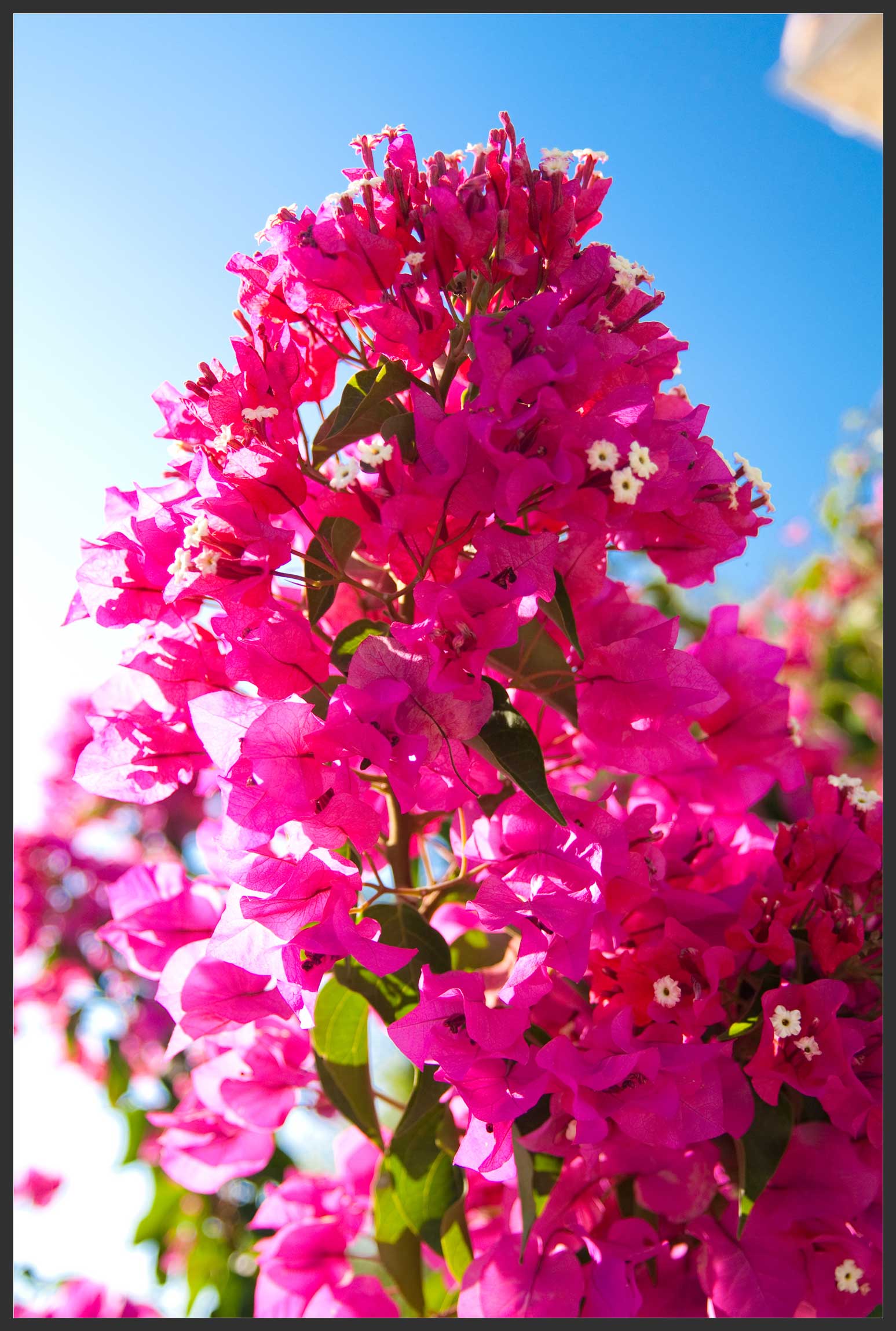
An example of the Cephallonian flora
Breakfast over and with the voices gaining in strength, we had to investigate. A number of villagers from Spartia had driven the mile down to the beach and were milling around an open door to the building. One local woman quickly saw our confusion and came over to explain.
As it turned out, the first day of our holiday had coincided with the yearly Mass celebrating St Nicolaos, the protector of sea-farers, and the ‘shed’ was in fact a small Greek Orthodox Church. Crammed inside, led by a priest, were a large number of folk taking part in the service. A quartet of strong male polyphonic voices lead the singing with worshipers coming and going in and out of the church as they took a break from the long service and the hot, airless atmosphere.
As the service came to an end, activity focused on an area under the pine trees. Large barbecues started smoking. Food was prepared, and the tables and chairs (brought down from the village on a tractor and trailer) arranged. Two musicians started playing and the delightful strains of mandolins filled the air. Generous slices of celebratory Artos (bread) coated in honey and decorated with flowers were passed round and small dishes of Kolyva made from boiled wheat, pine nuts, sugar-coated almonds and various fruits distributed.

Artos Bread
Some 60 villagers then settled down for a midday celebration of the Saint’s Day. The atmosphere was sheer enjoyment and soon circle dancing began. The musicians never stopped – even when villagers shook hands with them! We were welcomed into the celebrations, along with others who also accidentally stumbled into this happy gathering under a cloudless sky, with the Ionian Sea and the island of Zakynthos as backcloth.
With such a charming start to our holiday, what more surprises would Cephallonia have to offer, we wondered?
With the help of a hire car, definitely required for exploring as transport links are very infrequent, we set out to discover Cephallonia. It is a large island taking over two hours to drive from top to bottom. But with a population of only 35,000 and therefore relatively deserted roads, driving is a pleasure. In our 300 miles of motoring we came across only one set of (simple) traffic lights and three roundabouts (give way to traffic coming onto roundabouts)! The roads constantly twist and turn, but this meant that new views of wooded mountain sides, olive groves, vineyards, distant sandy bays and colourful villages constantly presented themselves.
The island’s history is fascinating, as it grew to prosperity on ancient trade routes linking Africa, Asia and Europe. Cephallonia has been invaded umpteen times and hill top castles such as the impressive fortress of St George, which dominates the south of the island, testify to the need for defence. Pirate raids also led to coastal villages being tucked into small bays with narrow streets to aid defence. We visited the fishing port of Assos half way up the west coast and our hearts almost ached at its beauty. Built on a narrow causeway leading to another vast fort, the village hugs the seafront of a small bay. The variously coloured buildings are in a Venetian style, built as they were during a period of Venetian rule. And how could the sea be any clearer and bluer than at Assos?
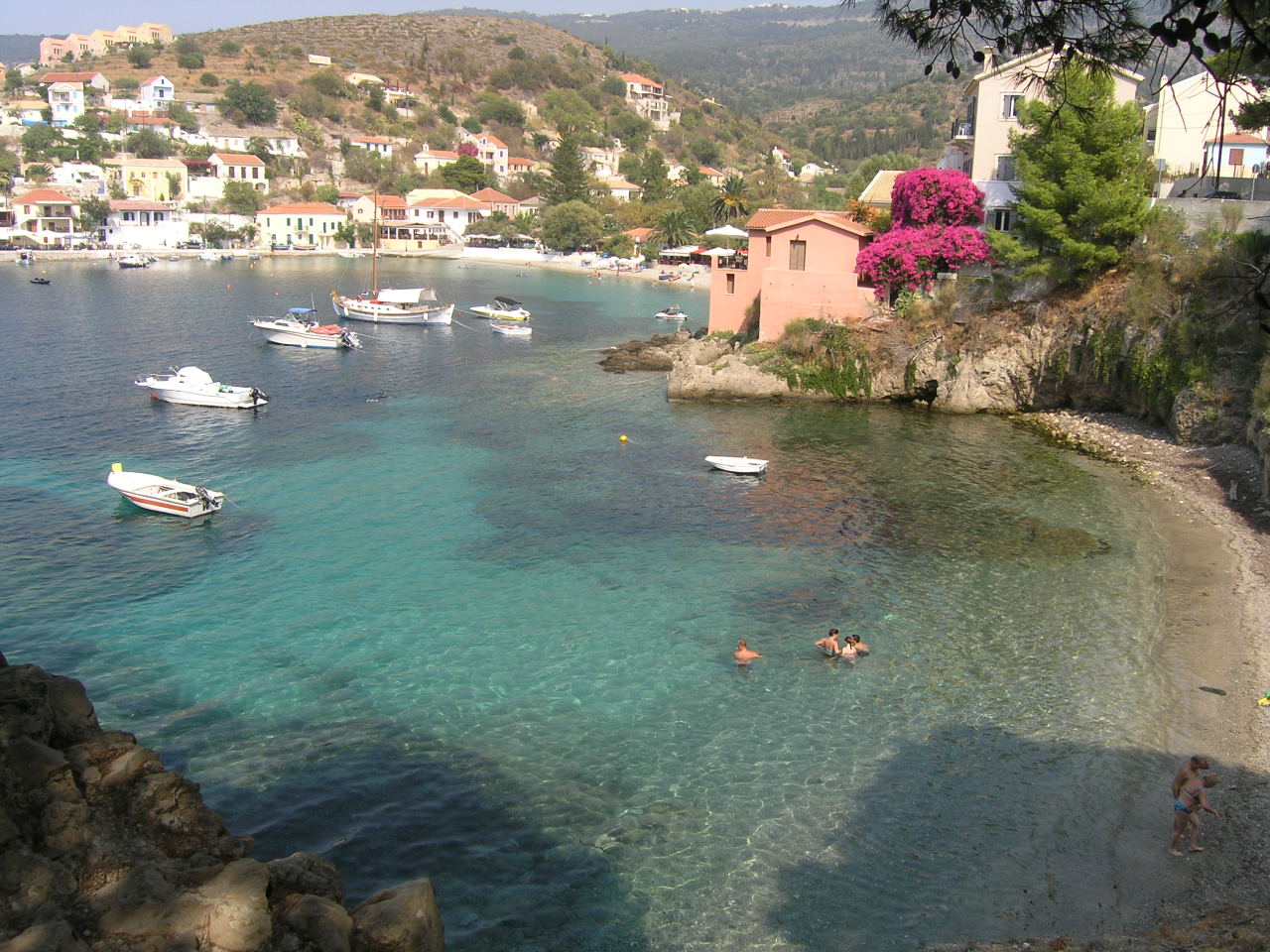
The beach at Assos
Well, within a few miles south there is the white sand of Myrtos beach and, yes, the sea is a yet more strikingly aquamarine blue and the scenery stunning. Our visit at the end of May found the flowers and shrubs of the island in full bloom. Broom, oleanders, geraniums and bougainvillea provided a wonderful contrast to the deep green of the cypress and fir trees. With windows wound down, our car was constantly filled with the scent from the maquis; hillsides of herby shrubs such as sage, thyme, juniper and myrtle.
Another small coastal village at the very northern end of the island is Fiskardo. The broad sweep of the tamarisk-lined promenade is lined with colourful, busy tavernas and these, in turn, are full of the crews from the numerous yachting flotillas that call in to moor overnight.
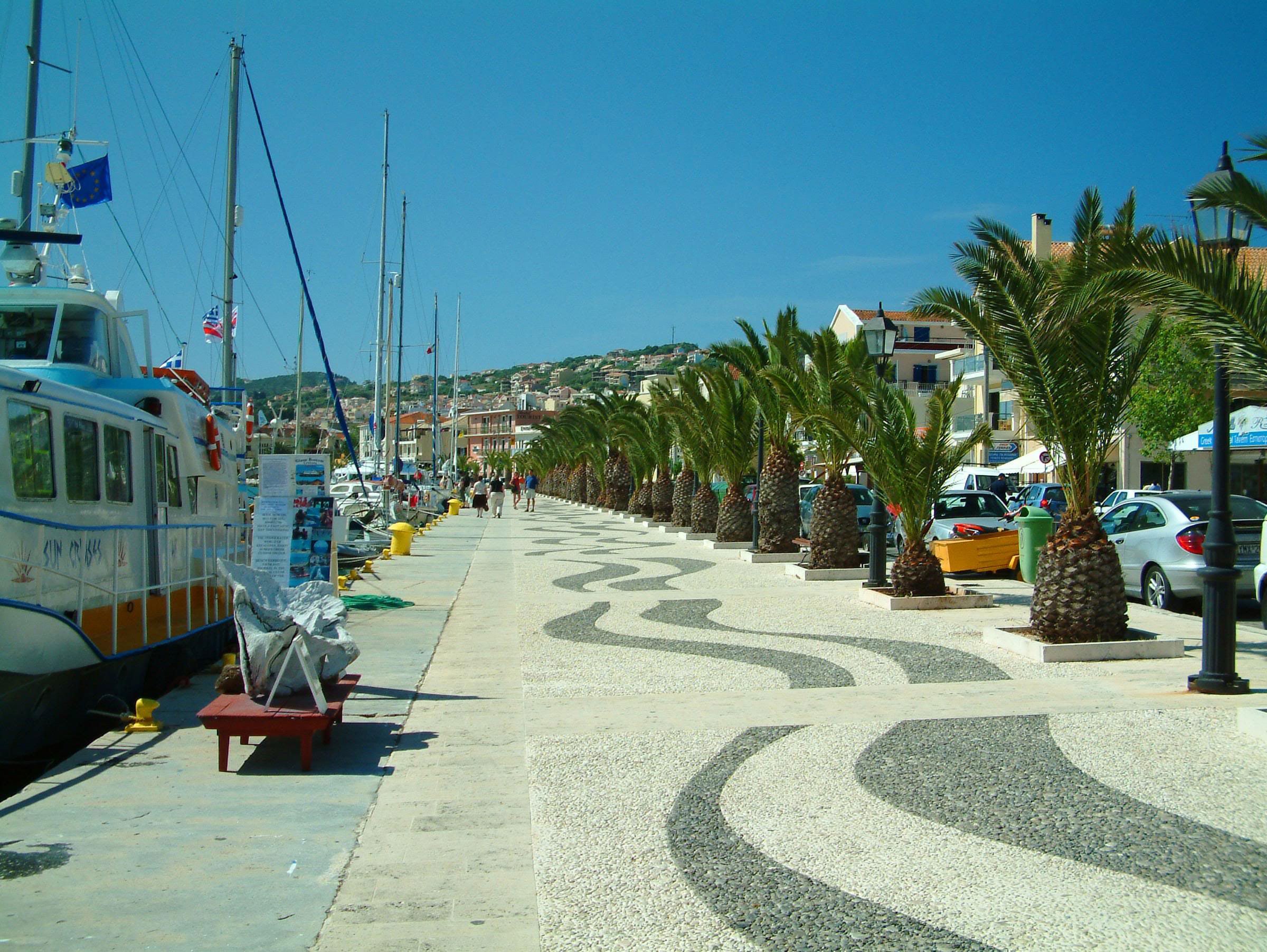
The promenade at Argostoli
Back towards the south of the island we visited the capital, Argostoli and spent most of the time down on the quayside sitting in a cafe watching for glimpses of the turtles which swim round the gently rocking fishing boats, hoping for scraps thrown overboard as the crew sorts its catch. We then set off inland and drove across to Sami on the east coast. With a slight detour, the drive takes the traveller through the fertile Ormala valley with numerous vineyards and the Robola winery where generous (virtually help yourself!) wine tasting is available. Alongside is a peaceful monastery linked to the very ornately decorated large Katholikon housing the remains of Agios Gerassimos, the patron saint of the island. Pilgrims from all over Greece join Cephallonians to celebrate his special feast days in August and October.
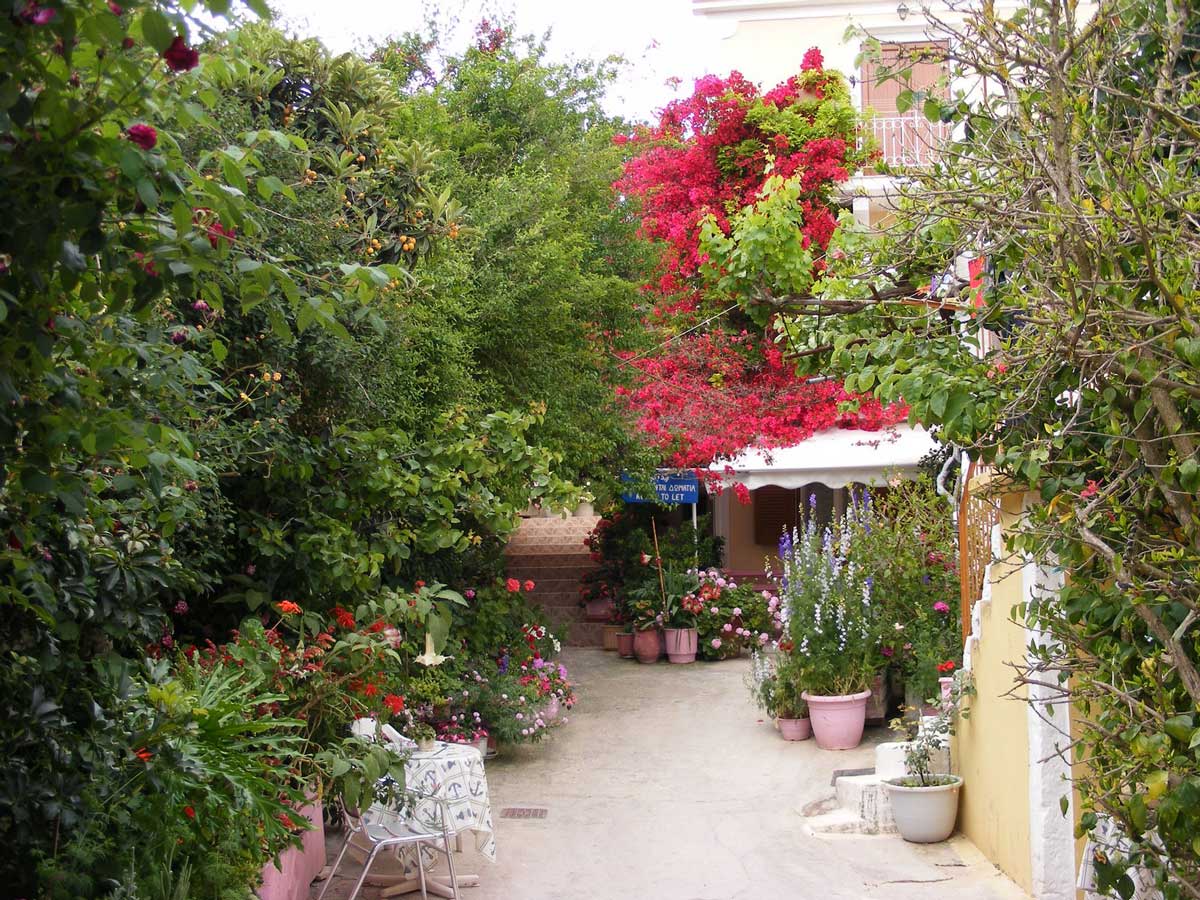
Fiskardo
On reaching Sami we parked by the little port and decided to follow a steep, well-marked footpath through thick woods up to the ruins of the Ag Fanentes monastery with fantastic views down over Sami and across to the neighbouring island of Ithaka. The deserted ruins remind the visitor of another important aspect of life on Cephallonia, namely the destructive earthquakes the island has experienced over the centuries. The last, in 1953, destroyed most of the existing buildings, and the Cephallonia one sees today chiefly dates from then. However, the buildings have been re built in the old style. We appreciated the lack of high-rise buildings on the island, although one or two such hotels are beginning to appear.
Cephallonia has been slow to develop its tourist industry. Our hotel was small, quiet and comfortable with good food. Tavernas have a relaxed atmosphere and many authentic Cephallonian wines and dishes along with more international fare. Roads and beaches are quiet, unless your visit is in the high season when you are likely to encounter numerous brightly coloured hire cars forlornly crisscrossing the minor roads and tracks, totally lost but enjoying the game of ‘spot the random direction sign’. One such adventurous car trip led us by good fortune to the delightful beach at Avythos on the south west coast. A stretch of golden sand with warm waters, some sun loungers and two tavernas were the sum total of this charming cove.
After a swim at Avythos, we sat in one of the tavernas and with a glass of wine, looked out to sea and watched the sunset. Complete relaxation. Only the swallows, back and forth to the nest full of youngsters some six feet above our heads, seemed not to have heard the message that Cephallonia is a place to relax, absorb the magical atmosphere and revel in the island’s surprises.
Mike Hampshire booked his hotel accommodation and flights through Sunisle Holidays. Visit www.sunisle.co.uk
You may also like to read
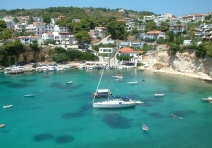
ALONIISSOS, GREECE
Another in Tour-smart's travels round the wonderfully diverse Greek Islands.

GREECE - CRETE
Tour-smart spotlights the largest of the Greek Islands - Crete.

Comments